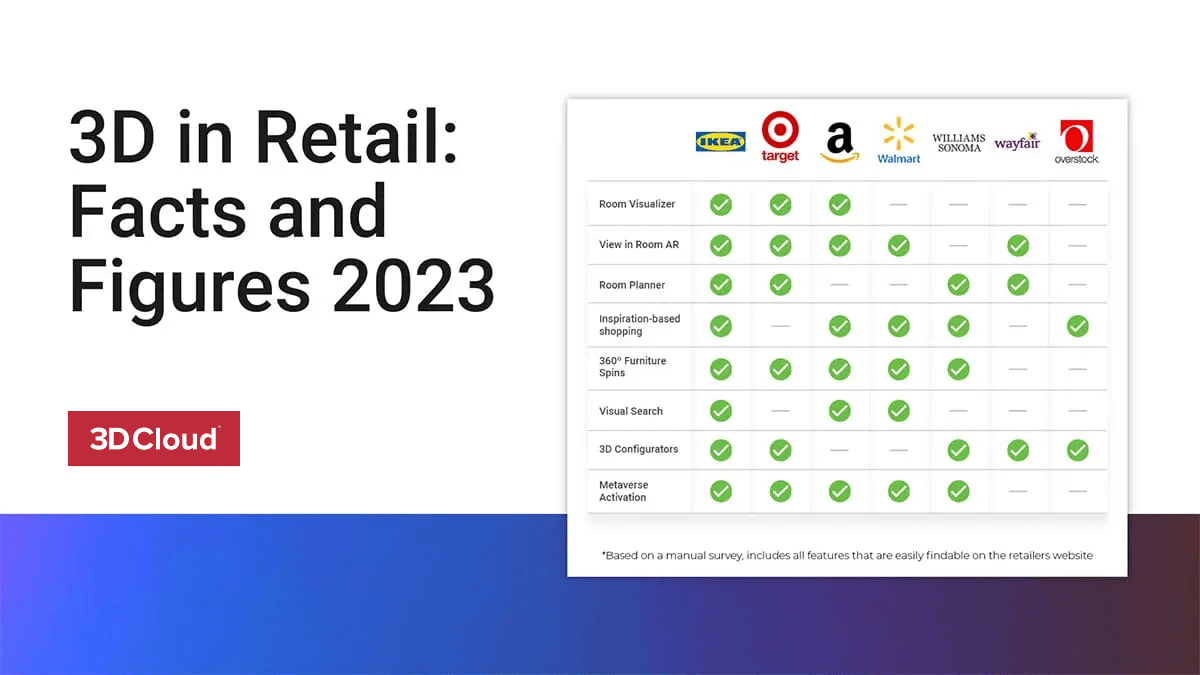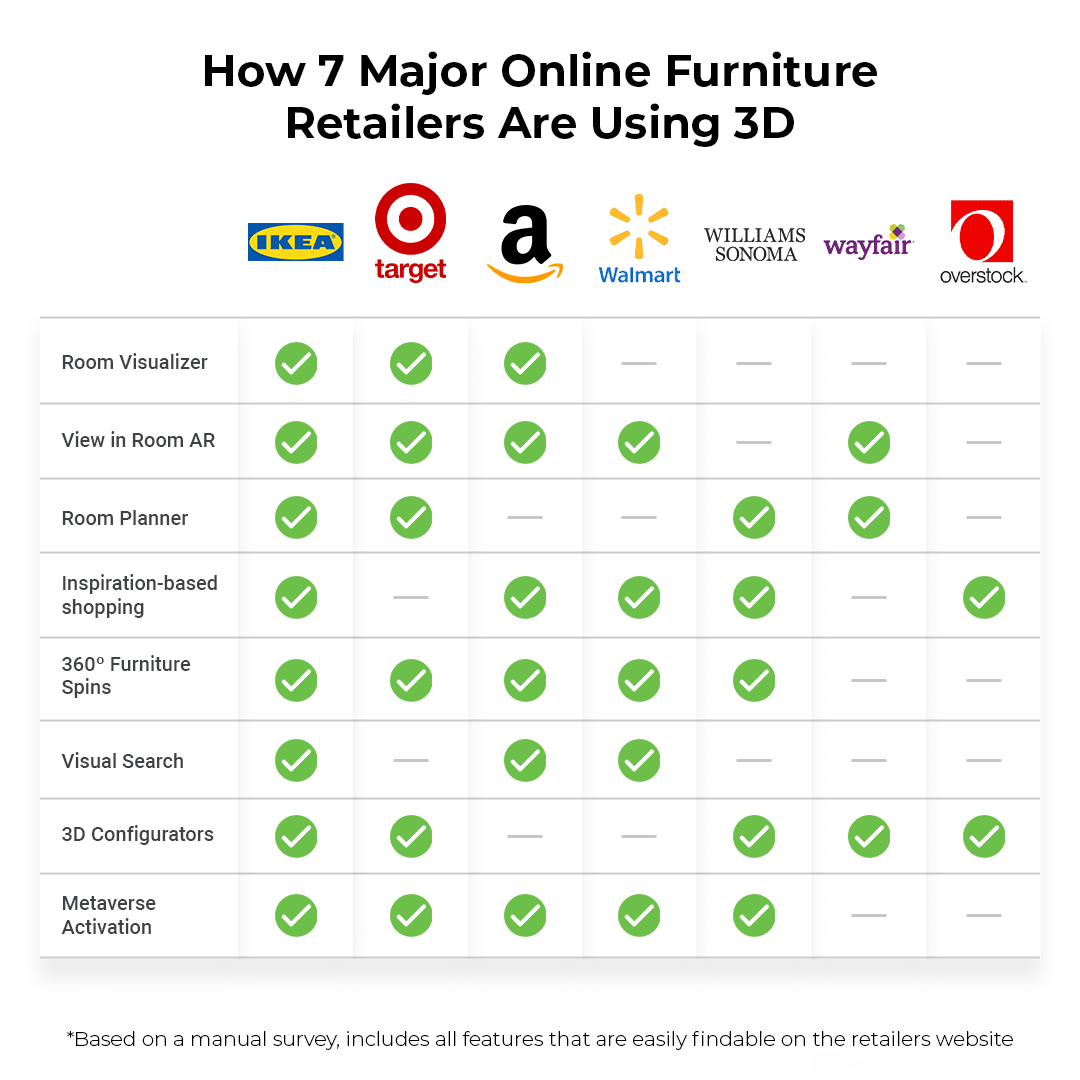
This article covers:
- 2023 is the year of hybrid retail experiences
- How 3D experiences engage customers
- 3D is working for retailers
- 3D performance benchmarks for furniture and DIY retailers
- 3D platforms vs. 3D point solutions
- INFOGRAPHIC: How 7 top online retailers are using 3D
From the Metaverse to AR everywhere, 2023 has brought a new degree of maturity to 3D — especially in furniture and home improvement. Here’s who’s using it, how 3D is delivering value, and where things are headed.
If you are in the process of developing a 3D commerce business case and are seeking market context on how enterprise retailers are investing in 3D experiences, this article is for you.
Once a darling of early adopters and innovators, 3D has reached general adoption among furniture and home improvement retailers. Here’s what you need to know about 3D adoption in 2023.
2023 is the year of hybrid retail experiences
According to Consumers Want It All, a 2022 study from the IBM Institute for Business Value (IBV), “Shopping can no longer be divided into online or offline experiences. Many consumers now prefer an ‘all-of-the above’ approach, visiting stores, shopping online, and using mobile apps interchangeably.”
Customers of home goods stores are more likely than other shoppers to engage in this “hybrid shopping.” Four in 10 home goods shoppers name hybrid shopping as their primary buying method vs. 27% across all retail categories. Another three in 10 home goods shoppers prefer an online-only experience. Likewise, Gen Z and Millenials are most likely to prefer hybrid or online-only experiences.
Given the shifting nature of shopping behavior, providing immersive and engaging digital experiences both online and in the store is crucial. As the IBV study concludes, “We believe hybrid shopping is here to stay and has become “table stakes” for consumers. Therefore, retailers need to create buying journeys that easily work no matter what path a customer takes.”
How 3D experiences engage customers
In a retail context, engaging activities educate, entertain, absorb, capture the imagination, spark creativity, inspire confidence, and create emotional connections. 3D visualization has all of these benefits.
Whether you sell furniture, kitchens, bathrooms, decking, closets, or curtains, customers on your website or in your store have two burning questions. The first is how a product will look in their home. The second is how much it will cost. 3D visualization and configuration can answer both questions. For instance, with the 3D Cloud 3D Room Planner, configure a custom space to show how things fit then add to cart or download a bill of materials to see the cost of a full room set.
3D product configurators are both interactive and engaging, allowing shoppers to personalize and purchase the products they want while providing retailers and manufacturers with an endless aisle.
Consumers say that they want 3D experiences. Harvard Business Review reported that 61% of shoppers say they prefer to shop with retailers that offer AR experiences. Likewise, 56% of shoppers say that AR gives them more confidence about the quality of a product.
61% of shoppers say they prefer to shop with retailers that offer AR experiences.
56% of shoppers say that AR gives them more confidence about the quality of a product.
SOURCE: Nielsen IQ Survey
Moreover, retailers are increasingly recognizing the benefits of 3D visualization and its role in engagement. In a 2022 Skyquest Technology survey of more than 1,000 senior retail executives around the world, nearly four of 10 furniture and consumer electronics businesses were already using or considering using AR, with their top use cases being product visualization (76%), customer engagement (73%), and marketing and advertising (73%).
4 in 10 furniture and consumer electronics businesses are investing in AR.
Top use cases include product visualization, customer engagement, and advertising.
SOURCE: 2022 Skyquest Technology survey
“The new 3D room planner tool enables our customers to recognize their room, creating an immediate emotional attachment,” said Vice President of Retail for Ballard Designs Dominic Milanese in a recent press release. “Guests feel more confident about their planned purchases. And our Designers love how quickly the tool lets them plan a space right before the guest’s delighted eyes.”
In kitchen and bath remodeling, a newly released SmartChart from the Research Institute for Cooking and Kitchen Intelligence (RICKI) reported that K&B designers chose design software as the most important sales tool they use, with 82% citing it as very important.
82% of kitchen designers believe that design software is the most important sales tool they use.
SOURCE: Research Institute For Cooking & Kitchen Intelligence
3D is working for retailers
One powerful benefit of 3D visualization tools with enhanced analytics capabilities is that retailers can see exactly how well their 3D investments are working. When 3D applications are integrated with first-party data such as online transaction events and in-store point-of-sale systems, it’s easy to see how 3D contributes to overall basket size and sales efficiencies.
A Shopify study released in January 2023 found that 3D images on product pages (PDPs) increase conversion rates by up to 250%.
3D images on product pages (PDPs) increase conversion rates by up to 250%.
SOURCE: Shopify
3D performance benchmarks for furniture and DIY retailers
3D Cloud® partners with retailers to track, measure and optimize the performance of 3D initiatives in order to ensure return on investment (ROI). Based on an aggregated view of performance across clients*, we know that
Clients offering WebAR on their websites see, annualized:
- 303,000 sessions with 404,000 AR views producing $3.44 million in revenue**
- 4.5x increase in cart conversion***
- 3.8x increase in direct return on investment (ROI)
WebAR case study – Jerome’s Furniture
Clients offering 3D product configurators on their websites see:
- 6 configurations per session on average
- 30% increase in add-to-cart rate
- 30% view in WebAR among retailers who offer the WebAR OnDemand option
- 80% reduction in time to market on new product configurators
Product Configurator case study – MillerKnoll
Clients offering a sectional configurator on their website see:
- 120% increase in average order value (AOV)
- 30% increase in add-to-cart rate
- 50% increase in cart conversion rate
- 2% cart conversion rate
Sectional Configurator innovation spotlight – American Furniture Warehouse
Clients offering 3D room planners on their website and/or through designers see:
- 30-minute average room planning session
- 60% increase in average order value
- 25% project save rate
- 2% add-to-cart rate
- 25% reduction in returns
3D Room Planner innovation spotlight – Ballard Designs
Clients offering a 3D deck designer:
- Generated over 25,000 sessions during last year’s peak decking season
- Achieved a nearly 3% dealer conversion rate
- Achieved a BOM rate typically over 11%
3D Deck Designer client video – Timbertech
3D platforms vs. 3D point solutions
Over the past five years, retailers investing in 3D have cobbled together agency and point solutions from different vendors. It made sense to use providers that specialized in individual 3D applications such as AR, room planning, or product configuration. Now that 3D for retail has matured, retailers have better, more cost-efficient options.
Using a single 3D vendor has a slew of benefits that range from a single content investment that can be spread across multiple applications, a better vendor relationship, and fewer internal resources required to manage partnerships and deployments.
“Shifts in consumer behavior have changed the decision-making process around investments in 3D,” said Beck Besecker, 3D Cloud’s CEO and Co-Founder. “Retailers are now looking at 3D as a platform investment rather than a series of one-off campaigns. Consumers want to shop visually with interactive 3D products and retailers want to make smarter investments,” Besecker said.
How 7 top online furniture retailers are investing in 3D
With hybrid shopping here to stay, retailers are growing engagement through immersive 3D experiences that scale both online and in-store. These 3D experiences are becoming part of their competitive advantage, as retailers see the investment as a way to strategically grow top-line revenues and simultaneously drive cost efficiencies.
We reviewed seven retailer websites to see what 3D experiences they are offering. This convenient matrix shows how 7 top online furniture retailers are investing in 3D.
- If you’re planning to invest in 3D and need to develop a 3D Business Case, you can include this infographic as part of your market analysis.
- Get an updated survey of what 3D initiatives are available on top retailer websites.
Download the How 7 top online furniture retailers are investing in 3D
Microsoft PPT | PDF
3D has reached general adoption and hybrid retailers will benefit from thinking strategically about their 3D investments rather than investing in one-and-done point solutions.
Now that you’ve educated yourself on 3D in retail facts and figures, what’s next?
As a next step, learn how to build a 3D content pipeline and how to build a 3D business use case. For a complete guide to launching a 3D project, visit our 3D Project Planning Resource Center. In the resource center you’ll find podcasts, articles, and more on how retailers are utilizing 3D to develop next-gen customer experiences.











